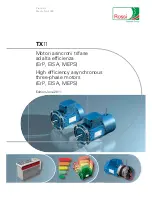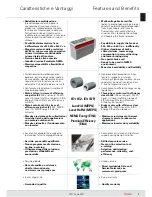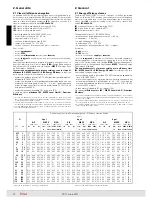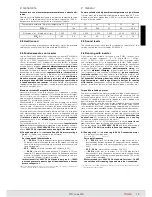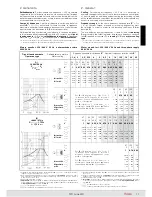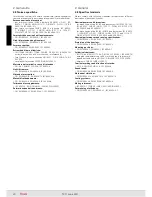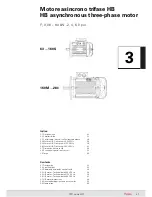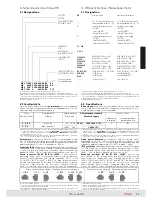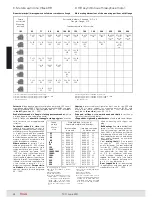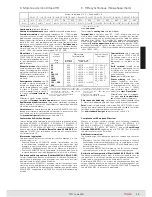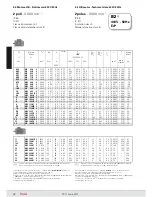
15
TX11 June 2011
Potenza resa con elevata temperatura ambiente o elevata alti-
tudine
Qualora il motore debba funzionare in ambiente a temperatura supe-
riore a 40 °C o ad altitudine sul livello del mare superiore a 1 000 m,
deve essere declassato in accordo con le seguenti tabelle:
Power available with high ambient temperature or high altitude
If motor must run in an ambient temperature higher than 40 °C or at
altitude at sea level higher than 1 000 m, it must be derated accor-
ding to following tables:
Temperatura ambiente - Ambient temperature [°C]
30
40
45
50
55
60
P/P
N
[%]
106
100
96,5
93
90
86,5
Altitudine s.l.m. - Altitude a.s.l. [m]
1 000
1 500
2 000
2 500
3 000
3 500
4 000
P/P
N
[%]
100
96
92
88
84
80
76
2.5 Livelli sonori
I livelli di emissione di potenza sonora
L
WA
per i motori del presente
catalogo sono conformi ai limiti previsti dalla EN 60034-9.
2.5 Sound levels
The sound power emission level
L
WA
relevant to the motor of this
catalog comply the limits settled by EN 60034-9.
2.6 Funzionamento con inverter
I motori Rossi sono adatti al funzionamento con inverter PWM (valo-
ri limite: frequenza portante 4
16 kHz, d
U
/d
t
1 kV/
s,
U
max
1 000 V,
U
N
500 V, lunghezza cavi
30 m; per valori superiori ved.
«Picchi di tensione (
U
max
), gradienti di tensione (d
U
/d
t
), lunghezza
cavi») in quanto adottano soluzioni costruttive e accorgimenti adatti
anche a questo impiego:
generoso dimensionamento elettroma-
gnetico
; impiego di
lamierino ma gnetico isolato
a basse perdite
(momento torcente più elevato sia ad alta sia a bassa frequenza,
buona risposta ai sovraccarichi);
separatori di fase, sistema isolan-
te
con elevato margine termico e dielettrico e ottima resistenza alle
sollecitazioni meccaniche e alle vibrazioni; ro tore con
equilibratura
dinamica accurata; cuscinetti con grasso per elevate tempera-
ture; ampia disponibilità di esecuzioni a catalogo specifiche per
il funzionamento con inverter
(servoventilatore, impregnazione
supplementare degli avvolgimenti, son de termiche bimetalliche o a
termistori, encoder, ecc.).
Momento torcente
M erogabile dal motore
L’inverter alimenta il motore a tensione
U
e frequenza
f
variabili
mantenendo costante il rapporto
U
/
f
(ricavabile dai valori di targa).
Per
U
U
rete, con
U
/
f
costante, il motore varia la propria velocità in
proporzione alla frequenza
f e, se caricato con il momento torcente
nominale
M
N
, assorbe una corrente
I
≈
I
N
.
All’aumentare di
f
, poiché l’inverter non può erogare in uscita una
ten sione superiore a quella di ingresso, quando
U
ha raggiunto il
va lore di rete,
U
/
f
decresce (il motore funziona sottoalimentato) e
con esso decresce proporzionalmente
M
a pari corrente assorbita.
Il motore asincrono trifase alimentato da inverter fornisce, a frequen-
za di alimentazione bassa per motivi termici, a frequenza alta per
motivi elettrici (
U
/
f
inferiore ai dati di targa), un momento torcente
M
inferiore a quello nominale
M
N
, in funzione della
frequenza
di funzionamento e del
raffreddamento
(motore autoventilato o
servoven tilato).
Per funzionamento a 2,5
f
5 Hz è necessario l’
inverter vetto-
riale
(per evitare funzionamento irregolare e assorbimento anomali).
Per motore avvolto
230 Y400 V 50 Hz
e inverter ad alimentazione
trifase
400 V 50 Hz si possono avere due tipi di funzionamento
.
A) Funzionamento a
U
/
f
≈
costante fino a 50 Hz
(
motore collega-
to a Y
; è il tipo di funzionamento più utilizzato):
P
a n max
≈
P
N
,
I
=
I
N 400 V
.
Per frequenza di alimentazione
:
–
5
1)
35,5 Hz
, il motore autoventilato è poco raffreddato quindi
M
diminuisce al diminuire della velocità (
M
rimane costante nel
caso di motore servoventilato o per servizio intermittente; ved.
linea tratteggiata);
–
35,5
50 Hz
, il motore funziona a
M
costante (
≈
M
N
);
–
50 Hz
, il motore funziona a potenza
P
costante (
≈
P
N
) con
rapporto
U/f
progressivamente ridotto (la frequenza aumenta
mentre la tensione rimane costante) e conseguente calo pro-
porzionale di
M
a pari corrente assorbita.
I motori avvolti a
400 V 50 Hz
(
standard per grand.
160M
)
possono avere solo questo tipo di funzionamento e devono
essere collegati a
.
2.6 Running with inverter
Rossi motors are suitable for running with PWM inverter (limit
values : chopper frequency 4
16 kHz, d
U
/d
t
1 kV/
s,
U
max
1 000 V,
U
N
500 V, wire length
30 m; for greater values
see «Voltage peaks (
U
max
), voltage gradients (d
U
/d
t
), cable length»)
since they are specifically conceived and featured by construction
solutions which also allow this kind of application. The most impor-
tant specifications are:
generous electromagnetic sizing
; use
of low-loss
electrical stamping
(higher torque both at high and
low frequency, good overload withstanding);
phase separators;
insulation system
with high thermal and dielectric margins and
great resistance to mechanical stresses and vibrations; rotor
care-
ful dynamical balancing; bearings with lubrication grease for
high temperatures; wide range of specific designs for running
with inverter
(independent cooling fan, additional windings impre-
gnation, bi-metal or thermistor type thermal probes, encoder, etc.).
Torque
M available on motor
The inverter supplies the motor at variable voltage
U
and frequency
f
by keeping constant the
U
/
f
ratio (which can be calculated with the
values on name plate). For
U
U
mains, with constant
U
/
f
, motor
changes its speed in proportion to frequency
f and, if loaded with
nominal torque
M
N
, absorbs a current
I
≈
I
N
.
When
f
increases, since the inverter cannot produce an output voltage
higher than the input one, when
U
reaches the mains value the
U
/
f
ratio decreases (motor runs under-voltage supplied) and at the same
time, with the same absorbed current,
M
proportionately decreases.
Asynchronous three-phase motor supplied by inverter provides, at
low frequency for thermal reasons, at high frequency for electrical
reasons (
U
/
f
lower than name plate data) a torque
M
lower than the
nominal one
M
N
, according to running
frequency
and to
cooling
(self-cooled or independently cooled motor).
For running at 2,5
f
5 Hz it is necessary to have a
vector inver-
ter
(to avoid any irregular running and anomalous absorption).
For motor wound for
230 Y400 V 50 Hz
and three-phase supply
inverter
400 V 50 Hz it is possible to have two running types
.
A) Running with
U
/
f
≈
constant up to 50 Hz
(
Y-connected motor
;
it is the most common one):
P
at n max
≈
P
N
,
I
=
I
N 400 V
.
For supply frequency
:
–
5
1)
35,5 Hz
, since self-cooled motor is slightly cooled,
M
is
decreased by decreasing speed (
M
keeps constant for indepen-
dently cooled motor or for intermittent duty; see short dashed
line);
–
35,5
50 Hz
, motor runs at constant
M
(
≈
M
N
);
–
50 Hz
, motor runs at constant
P
(
≈
P
N
) with progressively
decreased
U
/
f
ratio (frequency increases while voltage keeps
unchanged) and following proportional decrease of
M
at the
same current absorbed.
Motors wound for
400 V 50 Hz
(
standard for sizes
160M
)
can only have this running type and must be
-connected.
2. Generalità
2. General
1) Nel caso di alimentazione motore con inverter vettoriale, il momento torcente
M
per
servizio continuo rimane costante fino a circa 2,5 Hz.
1) In case of motor supply using vector inverter, for continuous duty torque
M
keeps
constant down to about 2,5 Hz.
Summary of Contents for TX11 Series
Page 2: ......
Page 203: ...203 TX11 June 2011...

